Keyword analysis is an essential part of any SEO strategy and Page One Power offers it as part of its own link building services.
Simply identifying which keywords and phrases are important to your website is not enough — you must analyze keywords to find where valuable opportunities lie and determine the path of least resistance.

In my last post on keyword research, I provided you with a starting point by teaching you how to find your seed keywords. Today, I want to demonstrate how to use your seed keywords to identify potential keyword opportunities.
I will use a running example again to make this process more tangible. My example for this post will be IT certification provider CompTIA.
Let’s dive into the keywords!
Analyzing Keywords and Opportunity
For the purpose of this post, I’ve already done preliminary keyword research and found the following seed keywords for CompTIA:
- [a+ certification]
- [security certification]
- [casp certification]
- [network certification]
- [it certifications]
- [cyber security certifications]
- [cyber security jobs]
- [information technology jobs]
- [cyber security training]
- [it careers]
- [it training]
- [a+ practice test]
- [cyber security career]
Using the process from my previous post I could undoubtedly find a handful more, but to demonstrate this next step these seed keywords will be enough.
I’ll analyze these key terms in a variety of areas, such as:
- Searcher intent.
- Search volume.
- Difficulty or competition.
- Related SERP features.
- Ranking pages.
Comparing each criterion will start to give me an idea of where opportunity may exist.
Searcher Intent
Searcher intent should always be a primary consideration when evaluating keywords.
If you rank for that keyword, how will that traffic impact your business?
Still struggling to integrate keyword research and content marketing? Download our checklist to learn how to integrate SEO into your larger marketing plan!
There are four main types of searcher intent for which every query falls within:
- Informational.
- Navigational.
- Commercial.
- Transactional.

Informational
Informational queries focus on obtaining specific information or finding an answer. These queries typically involve “who, “what”, when”, and “where” types of questions. Example: [what is a+ certification]
Keywords from seed list:
- [it certifications]
- [cyber security certifications]
- [cyber security jobs]
- [information technology jobs]
- [it careers]
- [cyber security career]
Navigational
Navigational searches are used to find specific web pages or sites. These queries often involve branded terms or product and service names. Example: [CompTIA certifications]
Keywords from seed list:
- N/A
Commercial
Commercial queries typically involve shopping or comparing vendors which make them a sort of hybrid of informational and transactional. These searches involve looking for information to inform a purchasing decision, but don’t always lead directly to a purchase. Example: [top rated IT certification courses]
Keywords from seed list:
- [a+ certification]
- [security certification]
- [casp certification]
- [network certification]
- [cyber security training]
- [it training]
Transactional
Transactional searches have the most commercial intent as these searchers are directly looking to make a purchase. Terms like “price,” “sale,” and “discount” are common among transactional queries. Example: [casp certification cost]
Keywords from seed list:
- [a+ practice test]
Understanding searcher intent helps you create targeted pages and better funnel traffic through your site.
Search Volume
Search volume for a given keyword is important because this volume gives you an idea of potential audience size. More monthly searches mean a larger audience.
Targeting larger audiences provides more exposure for your brand and a higher possibility of converting customers. However, search volume is only one data point in your broader keyword analysis and must be evaluated in conjunction with other factors (intent, difficulty, relevance, etc.)

Another important consideration is where your site is currently ranking for that keyword, and whether or not you can make meaningful improvements. Is your site ranking on page two? Three? 100?
Search volumes (SV) and rankings for CompTIA’s seed keywords are as follows (according to SEMrush):
- [a+ certification]: SV – 22,200; Rank – 1, 2, 3
- [cyber security jobs] SV – 14,800; Rank – Not ranking
- [security certification]: SV – 8,100; Rank – 1
- [network certification]: SV – 3,600; Rank – 1,2
- [it certifications]: SV – 8,100; Rank – 4, 5
- [cyber security certifications]: SV – 8,100; Rank – 12
- [information technology jobs]: SV – 8,100; Rank – 76
- [cyber security training] SV – 5,400; Rank – 39
- [it careers] SV – 4,400; Rank - 26
- [it training]: SV – 2,900; Rank – 11
- [a+ practice test]: SV – 2,900; Rank – 11
- [cyber security career] SV – 2,900; Rank – 9
- [casp certification]: SV – 1,600; Rank – 1, 2
Quickly scanning through these keywords I can pull out some potential opportunities based on search volume and ranking alone:
- [cyber security certifications]: SV – 8,100; Rank – 12
- [information technology jobs]: SV – 8,100; Rank – 76
- [cyber security training]: SV – 5,400; Rank – 39
- [it careers]: SV – 4,400; Rank - 26
- [it training]: SV – 2,900; Rank – 11
- [a+ practice test]: SV – 2,900; Rank – 11
With the right page and proper optimization, CompTIA could make improvements with these head terms and begin to capture new traffic.
Keyword Difficulty
One of the most important aspects of keyword analysis is measuring keyword difficulty.
You have two options for reviewing keyword difficulty or competition level: use an SEO tool or manually review search results. I’ll walk through both for CompTIA.
My three favorite tools for measuring keyword difficulty are Ahrefs, Moz’s Keyword Explorer, and SEMrush. Measuring keyword difficulty with these tools is fairly straightforward.
In Ahrefs, simply navigate to over to the ‘Keyword Explorer’ tab and enter in your keywords:
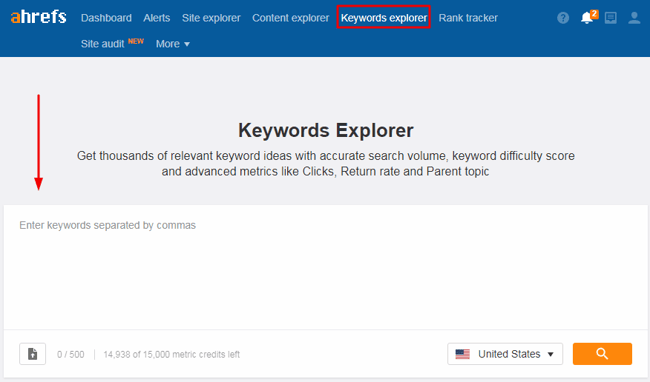
Once you input your key terms you can find “Keyword Difficulty” under the metrics tab, in the first column:
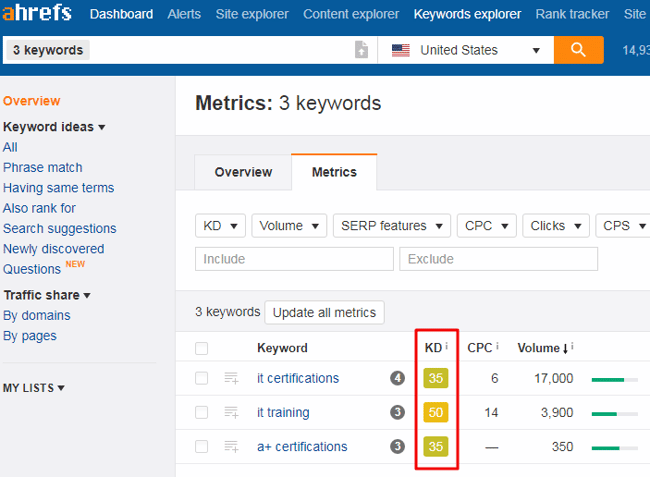
Ahrefs describes their difficulty metric as such:
“Keyword Difficulty is an estimate of how hard it would be to rank in Top 10 Google search results for a given keyword. It is measured on a non-linear scale from 1 to 100 (low difficulty to high difficulty).”
Similarly, with Moz’s Keyword Explorer you can enter in a term and “Difficulty” will pop up:
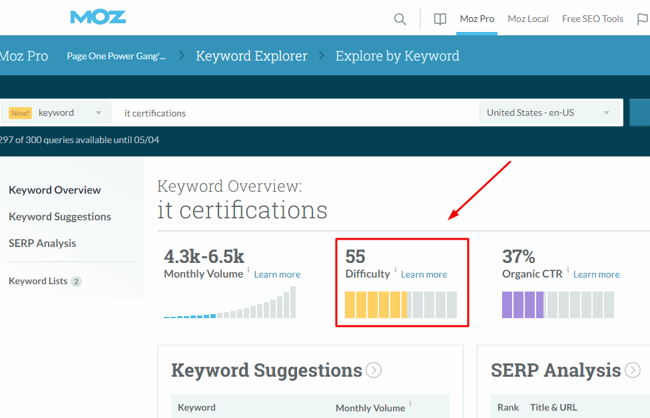
Moz defines difficulty as:
”A score from 0 (easy) to 100 (difficult) that estimates how difficult it is for you to rank higher than current competitors on the first page of search results.”
SEMrush is slightly different as they have a specific tab dedicated to “Keyword Difficulty”:
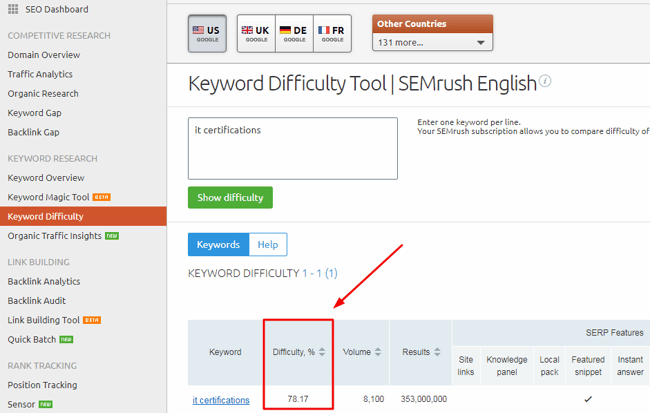
SEMrush calculates difficulty on a 1-100% scale and according to SEMrush:
“The higher the percentage, the more effort it will take to overrun your competition for targeted keywords.”
Using these three tools I can compare the competition levels for my seed keywords. (Note: I like to use more than one SEO tool whenever I'm evaluating tool metrics, because these metrics are merely barometers and it provides a more complete picture.)
Here are the prime opportunities, based on lowest keyword difficulty (along with current rankings):
- [a+ practice test]: (Rank – 11)
- Ahrefs: 10
- Moz: 30
- SEMrush: 63.46%
- [casp certification]: (Rank – 1,2)
- Ahrefs: 2
- Moz: 32
- SEMrush: 68.11%
- [cyber security certifications]: (Rank – 12)
- Ahrefs: 12
- Moz: 34
- SEMrush: 69.92%
- [cyber security career]: (Rank – 9)
- Ahrefs: 17
- Moz: 43
- SEMrush: 67.60%
- [it careers]: (Rank – 26)
- Ahrefs: 8
- Moz: 42
- SEMrush: 77.56%
Based purely off keyword difficulty, these would be the easiest terms for CompTIA to target. Of course, [casp certification] is immediately disqualified since CompTIA is already ranking for that term. However, the rest of these terms look like real opportunities.
SERP Features
SERP features should be a consideration because they influence content creation.
For example, if the SERP related to your target keyword features a rich snippet, you’ll want to optimize your content for that — providing a quick, concise answer or using a bullet list are effective formats for snippets. Ranking for snippets can be a great way to leapfrog tough competitors and jump above the “number one” spot.
In fact, CompTIA is being outranked in the rich snippet for [what is a+ certification] which is a certification they sponsor:
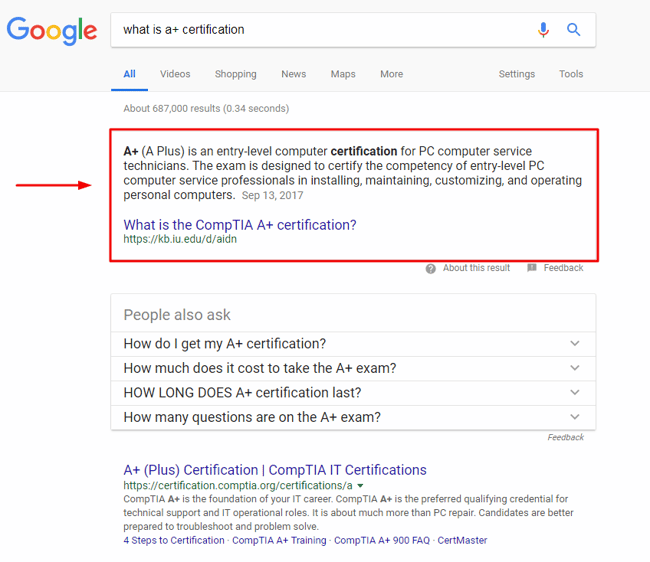
We can also see there is a “People also ask” box in this SERP. This box provides more information on related topics that should also be covered in your content.
Other important SERP features include:
- Knowledge card/panel.
- Local carousel.
- Maps.
- Reviews.
- Image results.
- Videos.
- Ads.
- In-depth article.
- News box.
SERP features should influence how you format and organize your pages, because optimizing for the prevailing features will give your content an advantage.
Current Ranking Pages
Analyzing current ranking pages is essential for any keyword or term you target.
Similar to SERP features, the ranking pages will inform page creation and provide insight into how you can rank your own content. For example, if the majority of ranking pages have embedded videos, it’s a good indication you should include a video on your page.

You can also draw inspiration from how existing ranking pages are structured. Do you notice any trends in how the pages are titled? How are these pages using H2s? H3s? Are there any common themes or formats that are driving success?
Ranking pages can also provide further insight into the competition level for your target keywords.
Search results that are full of large, recognizable brands typically indicate high competition level. Page quality is also an important signal for determining competitiveness — a SERP littered with poor results represents a prime opportunity to build a page that ranks.
Using our CompTIA example, I’ll investigate the SERP for [a+ practice test] since CompTIA is ranking near the bottom of page one (according to SEMrush). Here’s the results page:
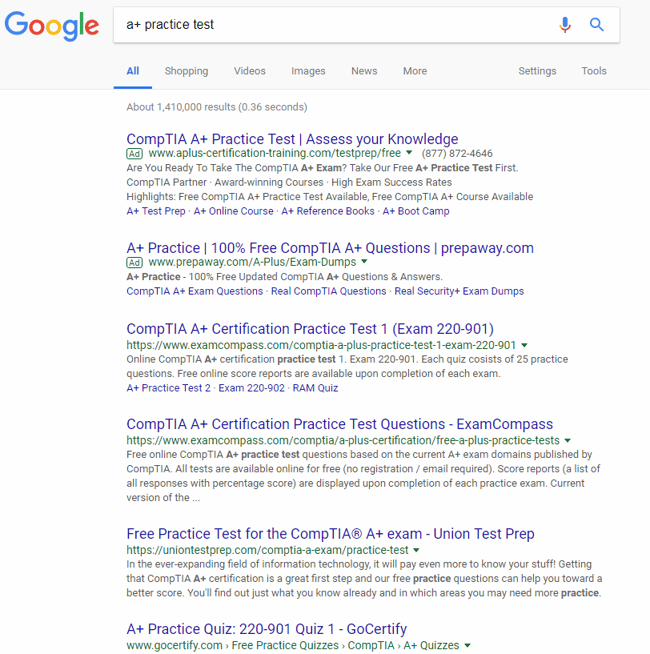
Ignoring the ads, I’ll examine the top three results;
ExamCompass:
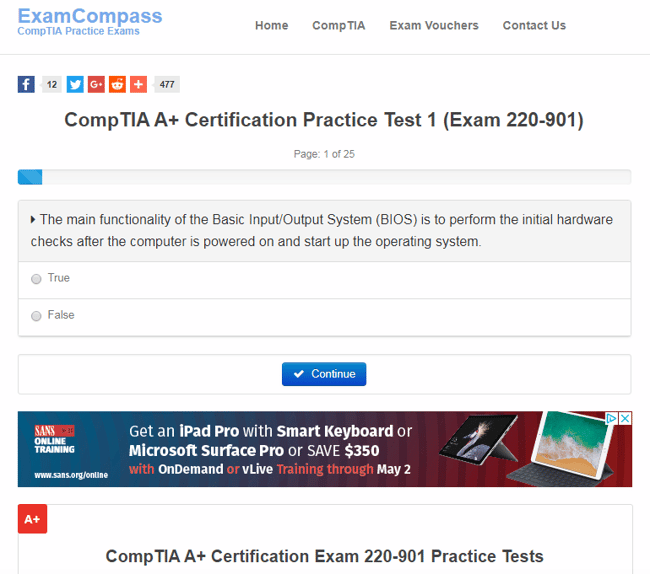
Union Test Prep:
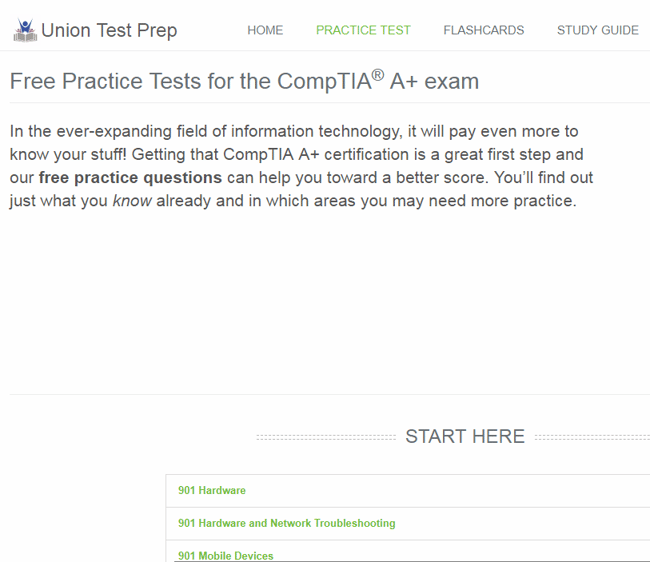
And GoCertify:
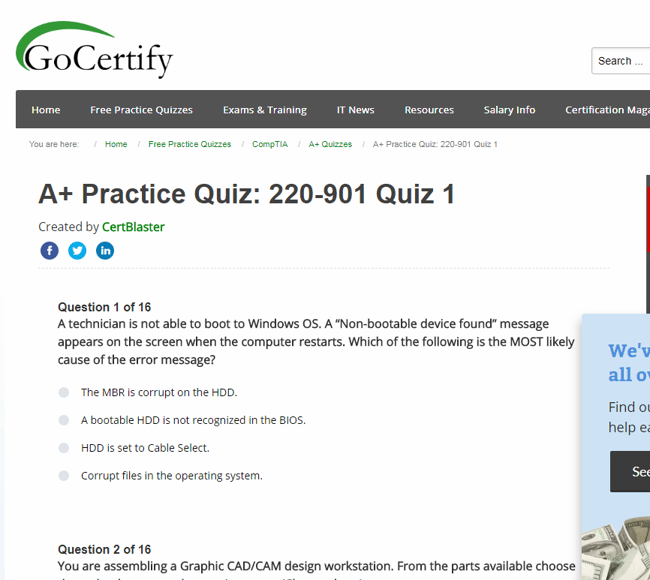
I notice that ExamCompass and GoCertify have actual questions and potential answers, while Union Test Prep offers explanations of each subject within the practice tests:
.png?width=650&height=388&name=Union%20Test%20Prep%20Screenshot%202%20(explanations).png)
If I compare these pages to CompTIA’s page I have a possible answer to why these pages are ranking higher:
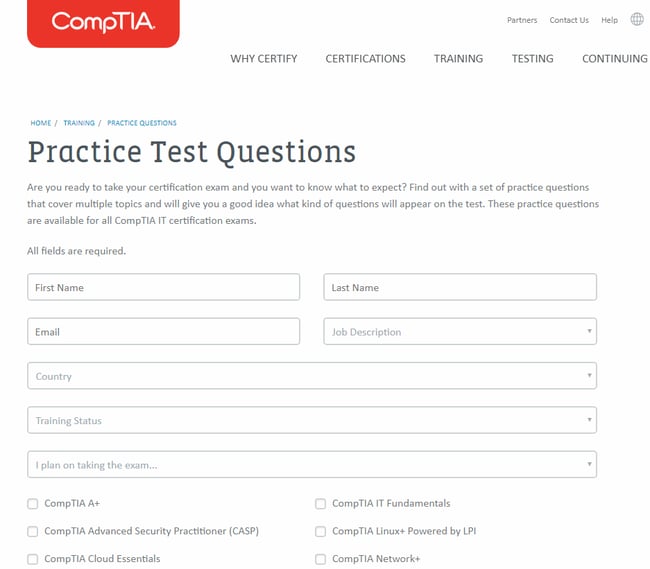
CompTIA’s test is gated, and their page is essentially a large form.
My guess is the other pages are ranking higher based on content. The ranking pages have actual questions and answers or in-depth copy about the elements of the test that Google can crawl. CompTIA’s practice test content is blocked by a form and Google is likely trying to serve more informative pages.
Of course, content is only half of the “content and links” equation.
You should always analyze the backlinks of ranking pages as aesthetics can sometimes be deceiving. These pages are ranking where you want to be and scrutinizing their backlinks will give you a target in terms of links.

While it seems content issues are the reason CompTIA is losing out in the [a+ practice test] SERP, it could very well be that links are the differentiator.
Using Majestic, I can compare link profiles for these three pages and CompTIA’s page.
Referring domains according to Majestic:
- ExamCompass: URL – 11; Root Domain - 734
- Union Test Prep: URL – 4; Root Doman - 518
- GoCertify: URL – 3; Root Domain – 2,477
- CompTIA: URL – 15; Root Domain (Subdomain) – 5,690
CompTIA has overwhelmingly more links, which reinforces the notion that they have an issue with onpage content. Of course, best practices would dictate running a link building campaign alongside any content updates to the page to maximize results.
Evaluating ranking pages during keyword analysis is crucial as these pages are your true competition.
Review
Keyword analysis is an integral step in keyword research.
Building a list of seed keywords is a solid starting point, but once you have those seed terms you need to begin analyzing them to identify potential opportunities.
Keyword analysis involves identifying potential opportunities based on:
- Searcher intent.
- Search volume.
- Difficulty or competition.
- Related SERP features.
- Ranking pages.
Each of these factors is part of the puzzle, and effective analysis will take all of them into account.
Once you have a firm understanding of where opportunities lie based on these criteria you can start grouping and prioritizing keywords to dictate strategy and page creation.
In my next post I’ll demonstrate how to prioritize keyword opportunities to ensure the SEO returns of your efforts are maximized.


